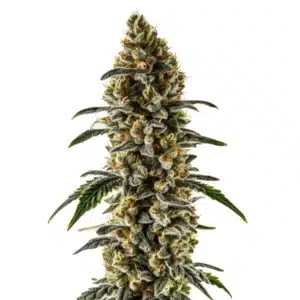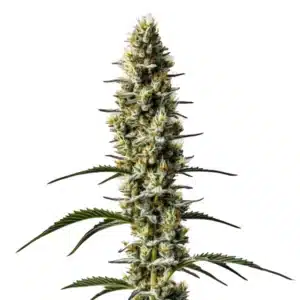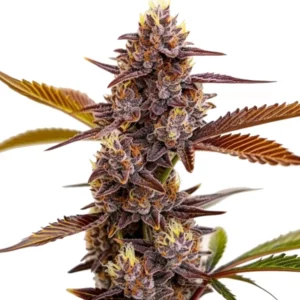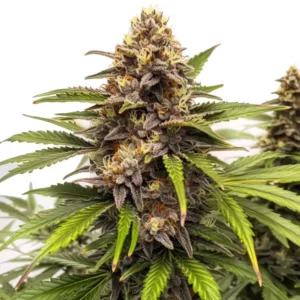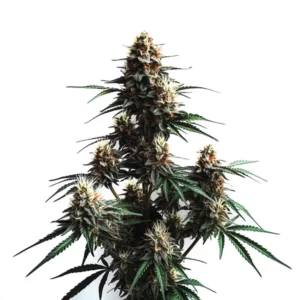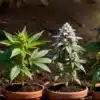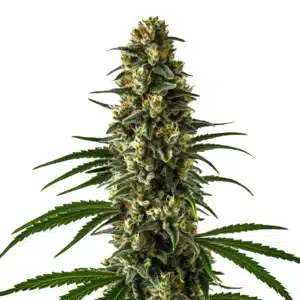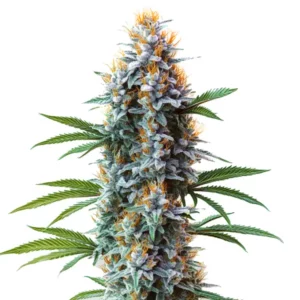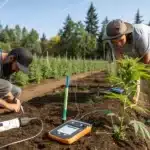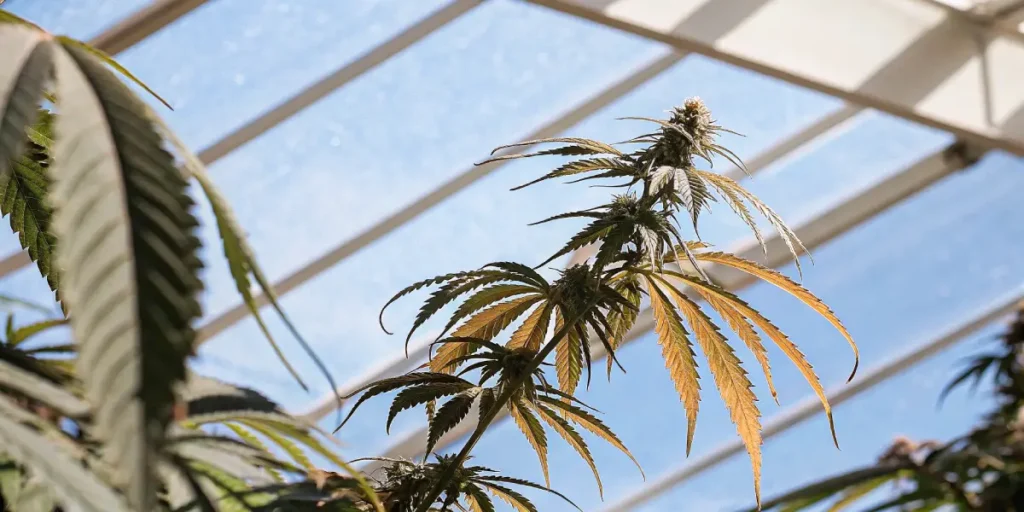
Signs of Overfeeding Cannabis
Growing cannabis can be a rewarding experience, but it comes with its challenges. One of the most common mistakes is overfeeding. When cannabis plants receive too many nutrients, they can show clear signs of stress. Recognizing the signs of overfeeding cannabis is essential to prevent damage. This stress often leads to cannabis leaf discoloration from overfeeding. The leaves might turn yellow, brown, or even curl up at the edges.
Another clear indication of overfeeding is the symptoms of cannabis nutrient burn. Nutrient burn often shows as brown or burnt tips on the leaves. This can affect the plant’s overall health and yield. It’s essential to monitor your feeding schedule and adjust as needed. Too much of a good thing can quickly turn into a problem.
Recommended Strains
Sweet Zombie
|
|
THC | 20% - 25% (Medium) |
|
|
Type | Feminized |
|
|
Yield | High |
|
|
Phenotype | 80% Indica / 20% Sativa |
Sweet Zombie Auto
|
|
THC | 18% - 20% (Medium) |
|
|
Type | Autoflowering |
|
|
Yield | Medium |
|
|
Phenotype | 65% Indica / 35% Sativa |
Knowing how to identify cannabis overfeeding can save your plants. Look for signs of nutrient toxicity in cannabis plants. These include dark green leaves, slow growth, and reduced bud development. By catching these signs early, you can adjust your feeding regimen and ensure healthy plant growth.
Common Symptoms of Cannabis Nutrient Burn
It’s crucial to recognize the signs of overfeeding cannabis early on. Brown leaf tips are a primary symptom. When the tips of the leaves start to turn brown, it usually means the plant is getting too many nutrients. This is a typical sign of nutrient burn.
Another indicator is the overall darkening of the leaves. Dark green leaves might seem healthy at first, but they can signal an overload of nitrogen. This is often accompanied by leaf curling, where the edges of the leaves start to curl under.
A less obvious symptom of cannabis nutrient burn is the weakening of the plant’s stems. Over time, excessive nutrients can cause the stems to become brittle and more susceptible to breakage. This not only impacts the plant’s structure but also affects its ability to support bud growth.
Additionally, overfed plants might exhibit uneven leaf growth, where new leaves develop at a slower or irregular rate compared to healthier plants. This inconsistency can be a subtle cue that something is amiss with your nutrient regimen, signaling the need for adjustment.
- Brown leaf tips.
- Dark green leaves.
- Leaf curling.
- Slow growth rate.
- Reduced bud development.
Promos & Deals
How to Identify Cannabis Overfeeding
Identifying overfeeding in cannabis plants is crucial for maintaining their health. One way to spot it is by examining the leaves. If you notice any unusual coloring or patterns, it might be a sign of overfeeding. Keep an eye out for signs of nutrient toxicity in cannabis plants.
Another method is to monitor the growth rate. Overfed plants often grow slower than their properly fed counterparts. This stunted growth is a red flag that something is off with your feeding schedule. Adjusting the nutrient levels can help restore normal growth.
When figuring out how to identify cannabis overfeeding, consider the plant’s overall appearance. A glossy sheen on the leaves might mistakenly be seen as a sign of health, but it could actually indicate excessive nutrient uptake. Observing the plant’s texture can offer additional clues.
Besides to visual inspection, keeping a log of your feeding schedule and plant responses can be invaluable. Documenting changes in the plant’s condition over time allows you to identify patterns and make informed decisions about adjusting nutrient levels.
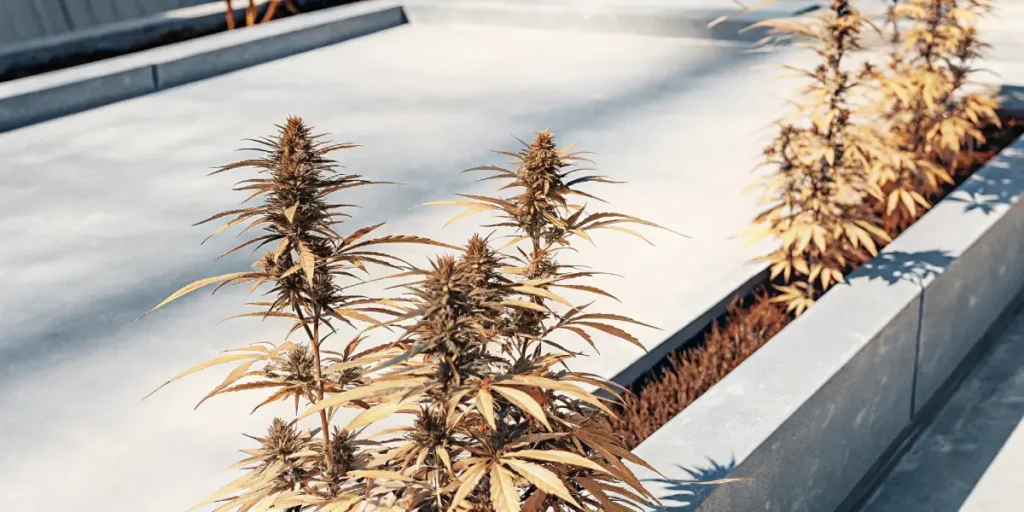
Preventing Cannabis Leaf Discoloration from Overfeeding
To prevent cannabis leaf discoloration from overfeeding, it’s important to recognize the signs of overfeeding cannabis early on. Start with a balanced nutrient solution and follow the manufacturer’s instructions closely, especially if you’re a first-time grower. Over time, you can adjust the nutrient levels based on your plant’s needs to avoid nutrient burn and other related issues.
It’s also helpful to flush the plants periodically. Flushing involves running water through the soil to wash away excess nutrients. This can help reset the nutrient levels and prevent buildup, which could lead to overfeeding.
Regularly checking the pH levels of your growing medium can also aid in preventing nutrient issues. A balanced pH ensures that nutrients are absorbed correctly, reducing the risk of cannabis leaf discoloration from overfeeding and promoting healthy plant development.
Moreover, utilizing a soil moisture meter can help you avoid over-watering, which often accompanies overfeeding. Ensuring that your plants receive the right amount of water, in conjunction with nutrients, is key to avoiding stress and leaf discoloration.
Signs of Nutrient Toxicity in Cannabis Plants
Nutrient toxicity occurs when cannabis plants absorb more nutrients than they need. This can lead to several issues, including leaf discoloration and curling. Recognizing these signs early can help you take corrective action.
One sign of nutrient toxicity in cannabis plants is the appearance of burnt leaf tips. These tips can turn brown and crispy, indicating that the plant is struggling with too many nutrients. Cutting back on the nutrient mix can help alleviate this problem.
Another symptom is the darkening of the leaves. While deep green leaves might seem healthy, they can actually signal an excess of nutrients, particularly nitrogen. This can eventually stunt the plant’s growth and affect its yield.
Besides to the physical signs, nutrient toxicity can also impact the plant’s root system. Over time, excess nutrients can lead to root binding, where the roots become tangled and compacted, impairing the plant’s ability to uptake water and nutrients effectively.
Observing the plant’s behavior during different light cycles can also provide insight into potential toxicity issues. Plants struggling with nutrient overload may exhibit wilting or drooping, especially during their dark period, indicating stress that needs to be addressed.
Managing Cannabis Plant Stress from Overfeeding
Stress from overfeeding can significantly impact the health of cannabis plants. Recognizing the signs of overfeeding cannabis is vital to address these issues promptly. One way to manage stress is by adjusting the feeding schedule. Reducing the amount of nutrients can help the plant recover.
Another strategy is to monitor the plant’s environment. Ensure that the growing conditions, such as temperature and humidity, are optimal. This can help reduce stress and allow the plant to focus on recovery.
Besides to environmental control, incorporating stress-reducing supplements like silica can enhance the plant’s resilience. These supplements can fortify the plant’s structure and improve its ability to handle nutrient fluctuations.
Regularly inspecting the plant for pests and diseases is also crucial when managing cannabis plant stress from overfeeding. A stressed plant can be more susceptible to infestations, so maintaining a healthy and clean growing environment is essential for recovery.
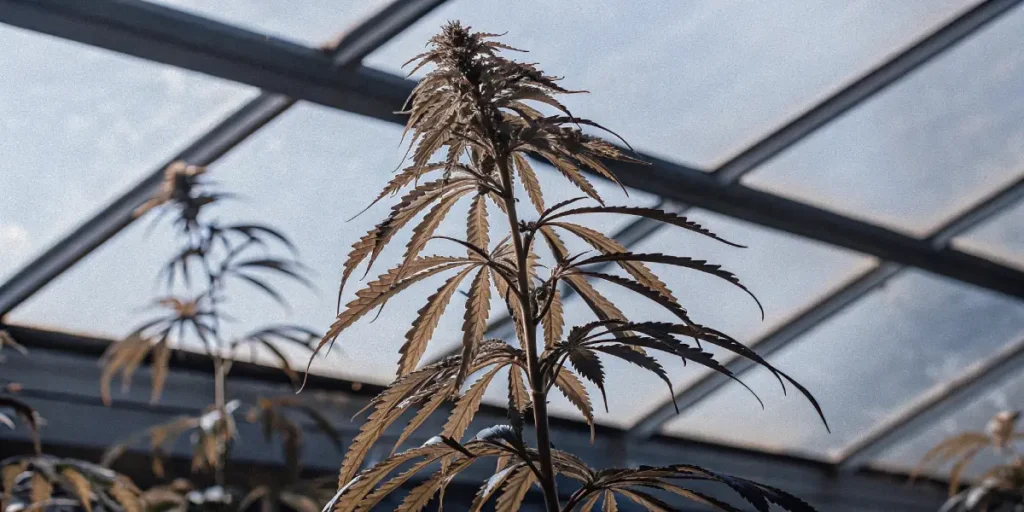
FAQs about signs of overfeeding cannabis
What are the signs of overfeeding cannabis?
Overfeeding cannabis often results in brown or burnt tips on the leaves. The leaves may darken, and you might notice them curling at the edges. These classic signs of overfeeding cannabis indicate nutrient burn, signaling that the plant is receiving too many nutrients.
Another sign is a slowdown in growth. Overfed cannabis plants might appear stunted compared to others. This can affect the plant’s ability to produce buds, ultimately impacting the yield. Monitoring these signs can help you adjust the nutrient levels accordingly.
Additionally, overfed cannabis plants might exhibit unusual leaf shapes or sizes. This morphological change can be a subtle indicator that the nutrient balance needs adjustment to restore optimal plant health and growth.
It’s also important to observe the root zone. Excessive nutrients can lead to root rot, which can be identified by a foul odor or discoloration of the roots. This is a more severe sign of overfeeding that requires immediate intervention.
How can I prevent cannabis leaf discoloration from overfeeding?
Preventing cannabis leaf discoloration involves starting with the right nutrient solution. Carefully follow the recommended feeding schedule and adjust as needed. Flushing the plants periodically can also help prevent nutrient buildup.
Choosing strains with known nutrient requirements, like those from Blimburn Seeds, can also aid in prevention. Strains such as Gorilla Glue 4 or Girl Scout Cookies may have specific needs, so knowing these can help maintain healthy plants without discoloration.
Implementing a regular schedule for monitoring and adjusting nutrient levels can help prevent potential issues. By proactively managing the nutrient intake, you can maintain healthy plant growth and avoid cannabis leaf discoloration from overfeeding.
Another preventive measure is to use organic fertilizers, which can be more forgiving and less likely to lead to nutrient burn compared to synthetic options. These natural fertilizers release nutrients slowly, reducing the risk of overfeeding.
What is nutrient toxicity in cannabis plants?
Nutrient toxicity occurs when cannabis plants absorb more nutrients than they can handle. This often results in symptoms like dark green leaves, burnt tips, and stunted growth. It’s crucial to recognize these signs early to prevent long-term damage.
Reducing nutrient levels and flushing the soil can help alleviate the toxicity. This allows the plant to recover and resume healthy growth. Keeping an eye on nutrient levels is essential to avoid toxicity in the future.
Nutrient toxicity can also manifest as an imbalance between different nutrients, where an excess of one nutrient causes deficiencies in others. Recognizing the signs of overfeeding cannabis is crucial, as this imbalance can lead to secondary symptoms, complicating the diagnosis and treatment of the issue.
Moreover, nutrient toxicity can impact the plant’s flowering stage, leading to poor bud formation and reduced potency. Addressing toxicity promptly ensures that the plant can produce high-quality flowers without compromise.
How do I manage cannabis plant stress from overfeeding?
Managing stress involves adjusting the nutrient regimen and ensuring optimal growing conditions. Reducing the amount of nutrients can help the plant recover from stress. Monitoring environmental factors like temperature and humidity is also vital.
Creating a stable growing environment helps minimize stress. For strains like Blackberry Moonrocks from Blimburn Seeds, knowing their unique needs can aid in managing stress effectively.
Incorporating regular pruning practices can also help manage stress by allowing better air circulation and light penetration, promoting healthier growth. Removing damaged leaves reduces the plant’s energy expenditure, allowing it to focus on recovery.
Another effective technique is to use beneficial microbes that can enhance nutrient uptake efficiency, helping the plant recover from previous overfeeding and improve its resilience against future stressors.
Can overfeeding affect the yield of cannabis plants?
Yes, overfeeding can significantly impact the yield. When a plant receives too many nutrients, it often results in stunted growth and reduced bud development. This ultimately affects the overall yield of the plant.
By identifying the signs of overfeeding cannabis early and adjusting the nutrient levels, you can ensure a healthy yield. Monitoring the plants and making necessary changes to the feeding schedule is essential for maximizing yield.
Besides to reduced yield, overfeeding can diminish the quality of the final product. Excessive nutrients can lead to harsher-tasting buds with less appealing aroma and potency, impacting the overall experience.
Therefore, maintaining a balanced nutrient profile throughout the plant’s lifecycle is crucial for achieving the desired yield and quality. Engaging in regular checks and adjustments can optimize both the quantity and quality of your harvest.


